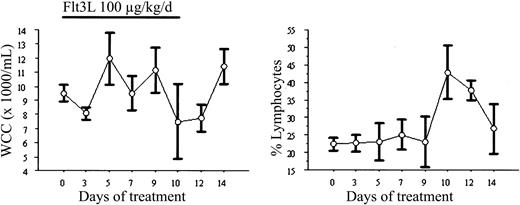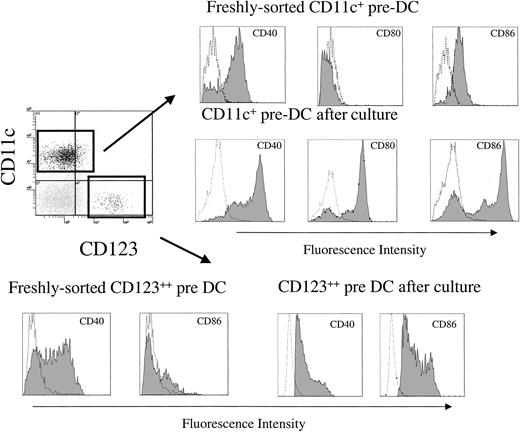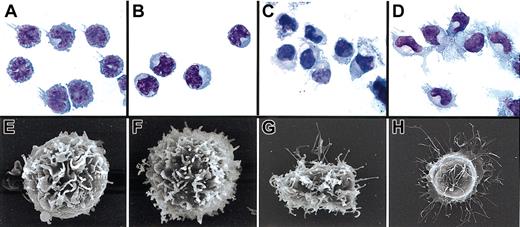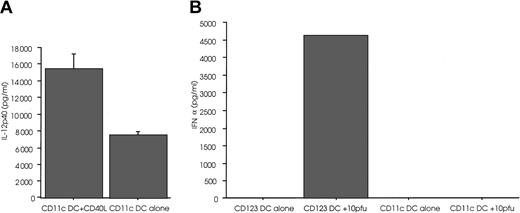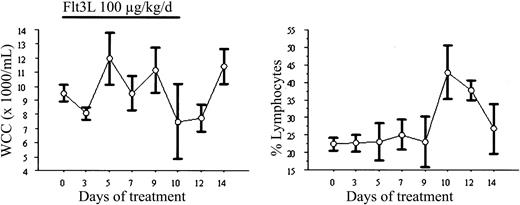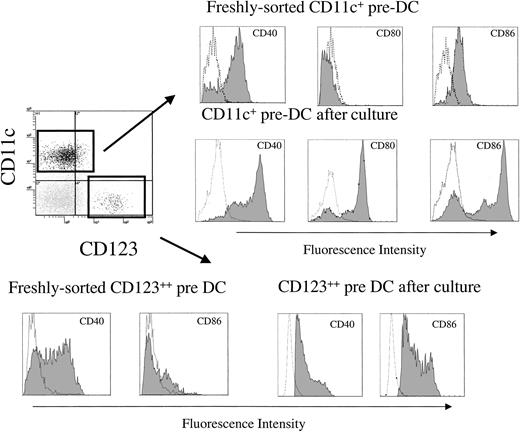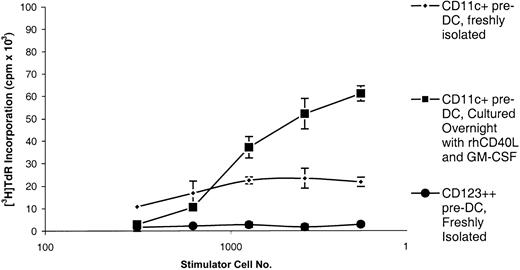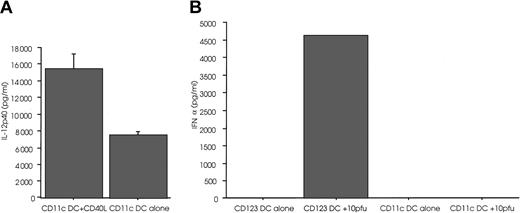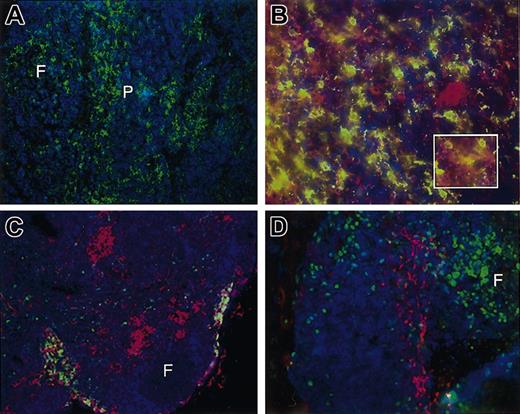Abstract
We provide phenotypic and functional evidence of premonocytoid dendritic cells (DCs) and preplasmacytoid DCs in blood and of corresponding DC subsets in secondary lymphoid tissue of rhesus monkeys. Subsets were identified and sorted by 4-color flow cytometry using antihuman monoclonal antibodies cross-reactive with rhesus monkey. To mobilize pre-DC subsets, fms-like tyrosine 3 kinase ligand (Flt3L; 100 μg/kg subcutaneously) was administered for 10 days. Presumptive pre-DC subsets were identified within the lineage- (Lin-) major histocompatibility complex (MHC) class II+ fraction of blood mononuclear cells. Premonocytoid DCs were CD11c+CD123- (interleukin-3Rα- [IL-3Rα-]). Preplasmacytoid DCs were characterized as CD11c-CD123++ Flt3L increased the CD11c+ pre-DC (7-fold) and CD123++ pre-DC subsets (3-fold) in blood. The freshly isolated CD11c+ pre-DC subset induced modest proliferation of naive allogeneic T cells. After overnight culture with granulocyte macro-phage-colony-stimulating factor (GMCSF) and CD40L, both subsets up-regulated surface costimulatory molecules, and CD11c+ pre-DCs became potent allostimulators. Freshly isolated CD123++ pre-DCs showed typical plasmacytoid morphology and, when cultured with IL-3 and CD40L for 72 hours, developed mature DC morphology. Following stimulation with CD40L, CD11c+ pre-DCs secreted increased levels of IL-12p40. Importantly, herpes simplex virus-stimulated CD123++ pre-DCs, but not CD11c+ pre-DCs, secreted interferon-α (IFN-α). Corresponding DC subsets were identified by flow analysis and immunohistochemistry in lymph nodes wherein both populations were increased 2- to 3-fold by Flt3L administration. CD123+ pre-DCs produced IFN-α in response to in vivo viral infection. Thus, rhesus monkeys exhibit 2 distinct DC precursor populations that closely resemble those of humans. Both are mobilized into blood and lymphoid tissue by Flt3L, offering potential for their further characterization and possible therapeutic application. (Blood. 2003;102:2513-2521)
Introduction
Dendritic cells (DCs) are rare bone marrow (BM)-derived antigen-presenting cells (APCs) present in blood and almost all other tissues. They are highly specialized for antigen uptake and processing and for the initiation and regulation of innate and adaptive immune responses. 1,2 They play important roles in the outcomes of BM and solid organ transplantation.3-5 In recent years, it has become increasingly clear that DCs are a heterogeneous population composed of several subsets that share common features but that also exhibit distinct biologic properties.6,7 In humans, blood-borne precursors (pre) of tissue DCs may be classified as 2 subsets, CD11c+ pre-DCs (monocytoid) and CD123++ pre-DCs (plasmacytoid). Monocytoid DCs are classical immunosurveillance cells that endocytose and subsequently present antigen to T cells in the context of cell surface major histocompatibility complex (MHC) molecules. In the normal steady state, immature DCs that engulf and present self-antigen to T cells in the absence of adequate costimulatory molecule expression may play a key role in the induction/maintenance of peripheral tolerance.8 Mature human monocytoid DCs induce mostly helper T1 (TH1) cell responses. Plasmacytoid DCs—the major type-1 interferon (IFN)-producing cells of human blood—are believed to be important in antiviral responses.9 After in vitro maturation with interleukin-3 (IL-3) and CD40L, plasmacytoid DCs promote polarization of TH cells toward TH2 responses,10 although the capacity of these cells to induce TH1 responses has also been described.11
Hematopoietic growth factors (HGFs) such as fms-like tyrosine kinase 3-ligand (Flt3L) and granulocyte colony-stimulating factor (G-CSF) mobilize CD11c+ pre-DC (Flt3L) and CD123++ pre-DC subsets (Flt3L, G-CSF) in humans.12-14 Flt3L also markedly increases CD34+ stem cells in rodents and rhesus monkeys.15 Mobilization of DC subsets into the peripheral circulation with HGFs renders these cells accessible for harvesting and for potential use as immunologic therapy.
Nonhuman primates (NHPs) are important in the assessment of new immunologic therapies of infectious diseases16 and allograft rejection17,18 because their immune systems closely resemble those of humans. Moreover, because there are differences between murine and human DCs, in phenotype and in function, direct extrapolation from rodent data to humans can be difficult. Thus there is a clear need to identify and functionally characterize NHP DCs to define their relationship to human DC subsets.
In this report, we describe properties of DC subsets in the peripheral blood and lymph nodes of normal and Flt3L-treated rhesus monkeys. Because rhesus macaques are used for the study of a wide variety of human disorders, a detailed understanding of their DC subsets has important implications for the interpretation of immune responses in these models. The major finding of this study is the identification and characterization of 2 pre-DC populations in rhesus monkeys with phenotypes and function similar to those in humans. We demonstrate that these rhesus pre-DCs may be mobilized with Flt3L, making them amenable to collection by venesection or leukapheresis and subsequent investigation in vivo and in vitro.
Materials and methods
Animals
Simian immunodeficiency virus (SIV)-negative, herpes B virus (HBV)-negative rhesus macaque monkeys (Macacca mulatta), aged between 1 and 5 years, were housed within the Primate Infectious Disease Research Facility of the University of Pittsburgh. All monkeys were maintained in accordance with guidelines set forth by the Institutional Animal Care and Use Committee, which included a specific environmental enrichment program.
Reagents
Fluorescein isothiocyanate (FITC)-, phycoerythrin (PE)-, Cy-Chrome-, or APC-conjugated mouse antihuman monoclonal antibodies (mAbs) used to detect cell surface MHC class II (clone G46-6), CD3 (clone SP34), CD11c (clone S-HCL-3), CD14 (clone M5E2), CD16 (clone 3G8), CD20 (clone 2H7), CD34 (clone 563), CD56 (clone MY31), CD80 (clone L307.4), CD86 (clone FUN-1), and CD123 (clone 7G3) expression by flow cytometry were purchased from BD PharMingen (San Diego, CA). Human DC-specific mAbs BDCA-1, BDCA-2, BDCA-3, and BDCA-419 were purchased from Miltenyi-Biotech (Bergisch Gladbach, Germany). Antihuman CD40 (clone MAB89) immunoglobulin G (IgG) mAb was purchased from Coulter Immunotech (Marseilles, France). Antihuman Fascin (p55) and Ki-67 were purchased from DAKO (Glostrup, Denmark). Recombinant (r) Chinese hamster ovary cell-derived human (h) Flt3L and trimeric rhCD40L were kindly provided by Immunex (now Amgen; Seattle, WA). Human rIL-3, recombinant human granulocyte macrophage-colony stimulating factor (rhGM-CSF), and rhIL-4 were purchased from PeproTech (Rocky Hill, NJ). RPMI 1640 (Life Technologies, Rockville, MD) was supplemented with 10% wt/vol fetal calf serum (FCS; Nalgene, Miami, FL), nonessential amino acids, l-glutamine, sodium pyruvate, penicillin-streptomycin, and β-2-mercaptoethanol (all Life Technologies) and is referred to subsequently as complete medium.
Flow cytometric analysis and cell sorting
Leukocytes isolated from whole blood by Ficoll gradient centrifugation were first blocked with 10% vol/vol normal goat serum (Invitrogen, Carlsbad, CA) for 20 minutes at 4°C, then were stained with mAb for 30 minutes at 4°C. Cells were also incubated with isotype-matched immunoglobulins (BD PharMingen) as negative controls. After staining, the cells were fixed with 1% wt/vol paraformaldehyde and analyzed on a Coulter EPICS Elite flow cytometer (Beckman Coulter, Hialeah, FL). For cell isolation, DC subsets were flow-sorted using a high speed MoFlow cell sorter (Cytomation, Fort Collins, CO). In some flow-sorting experiments, BDCA-1 was substituted for CD11c as an alternative myeloid DC marker. Absolute DC numbers were calculated by multiplication of the percentage of either CD11c+ or CD123++ cells within the lineage- (Lin-) MHC class II+ fraction by the percentage of Lin- MHC class II+ cells of the total peripheral white cell count (as measured by Coulter counter).
Mixed leukocyte reaction
Allogeneic peripheral blood mononuclear cells (PBMCs) isolated over Ficoll-Hypaque were used as responders. Then 2 × 105 responder cells were placed in each well of a 96-well, round-bottom plate, and graded concentrations of γ-irradiated (2 Gy) flow-sorted CD11c+ pre-DCs or CD123++ pre-DCs were added as stimulators. Cultures were incubated in complete medium for 5 days in a humidified atmosphere of 5% CO2 in air. [3H] TdR (titrated thymidine; 1 μCi [0.037 MBq] in 10 μL) was added to each well during the final 18 hours of culture. Cells were harvested using a multiple harvester (Tomtek, Turku, Finland), and [3H] TdR incorporation was determined in a liquid scintillation counter. Results are expressed as the mean cycles per minute (cpm) ±1 SD from triplicate cultures.
Immunohistochemistry and cytochemistry
Tissue blocks were fixed in 2% vol/vol paraformaldehyde for 1 hour at 4°C, then infused with 30% wt/vol sucrose overnight. Tissues were then frozen with an aerosol of 1,1,1,2 tetrafluoroethane (Fisher Scientific, Pittsburgh, PA) and stored at -70°C. Frozen sections (8 μm) were collected onto superfrost slides (Fisher Scientific) and incubated with mAb against human CD11c, CD123, Fascin (p55), or isotype-matched control immunoglobulin. For single-label experiments, a goat antimouse IgG conjugated with FITC was used. For double-label experiments, a goat antimouse FITC conjugate was used (Alexa 488; Molecular Probes, Eugene, OR). In some experiments, CD123 biotin was used with a streptavidin conjugate (both BD PharMingen). Cytospin preparations of flow-sorted Brefeldin A treated (10 μg/mL; Sigma, St Louis, MO) pre-DC subsets were stained overnight at 4°C for IFN-α with biotinylated mouse antihuman IFN-α (clone MMHA-14; PBL Biomedical Laboratories, St Louis, MO) followed by cytochrome 3 (Cy3) streptavidin (Jackson ImmunoResearch Labs, West Grove, PA) for 30 minutes at room temperature. Nuclei were stained with 4,6 diamidino-2 phenylindole (DAPI; Molecular Probes).
Quantitation of cytokine secretion
The capacity of freshly isolated rhesus monkey pre-DC subsets to secrete IFN-α was assessed by culture of sorted cells with herpes simplex virus-1 (HSV-1) (Kos strain) at 5, 10, or 25 plaque-forming units (pfu) per cell. Culture supernatants were collected after 24 hours and analyzed using a multispecies IFN-α enzyme-linked immunosorbent assay (ELISA) kit (PBL Biomedical Laboratories). The limit of detection was 156 pg/mL. Secretion of IL-12 by rhCD40L-stimulated DCs was determined using a rhesus monkey IL-12 p40 ELISA kit purchased from Biosource (Camarillo, CA). The limit of detection was 11.7 pg/mL.
Morphologic analyses
Flow-sorted CD11c+ pre-DCs and CD123++ pre-DCs were examined before and after culture by light and scanning electron microscopy (SEM). For cytospins, pre-DCs were spun onto glass slides using a Shandon cytocentrifuge (Shandon, Cheshire, United Kingdom) (230g) and then stained with May-Grünwald-Giemsa. For SEM, flow-sorted DC subsets were attached to glass coverslips pretreated with 0.1% wt/vol poly l-lysine. Subsequently, the cells were fixed in 2.5% vol/vol glutaraldehyde, dehydrated, coated with 20-nm evaporated carbon, and analyzed in a JEOL 35 scanning electron microscope (JEOL USA, Peabody, MA).
Lymph node suspensions
Lymph nodes from normal or Flt3L-treated animals were disrupted by incubation with DNase I (Roche, Mannheim Germany) (20 μg/mL) and collagenase (Sigma) (1 mg/mL), followed by a 30-minute incubation at room temperature. Cell suspensions were then prepared by passage through a metal sieve and centrifugation before washing and either freezing for storage or immediate flow cytometric analysis.
Viral infection of monkeys with influenza A
Influenza-naive monkeys were infected by intranasal instillation of 1 mL (0.5 mL per nostril) solution containing 106 TCID50 of A/Sydney/5/97-like virus (H3N2) as described.20 Infection was confirmed by nasal swabbing performed on days 1 to 7 after infection for measurement of TCID50 in MDCK cells.20 In some monkeys, Flt3L (100 μg/kg/d) was administered for 10 days before viral infection, and blood and lymphoid tissues were collected 3 and 5 days later.
Statistical analyses
Differences between control and treatment groups in hemoglobin level, white blood cell count, platelet count, and percentage of lymphocytes in peripheral blood were determined using the paired Student t test. P values less than .05 were considered significant. The Mann-Whitney U test was also used to determine differences between blood DC parameters before and after Flt3L administration.
Results
Simultaneous identification of presumptive pre-DC subsets within rhesus monkey peripheral blood by rare-event flow cytometric analysis
Presumptive pre-DCs were identified within the heparinized PBMC fraction of normal and Flt3L-treated rhesus macaques using antihuman mAbs known to cross-react with this species. Cells isolated over Ficoll-Hypaque were stained with a lineage cocktail of FITC-conjugated mAbs comprising anti-CD3 (pan T-cell marker), CD14 (monocyte), and CD20 (B) cells. Initially, the natural killer (NK) cell marker CD16 was included in the lineage cocktail; however, during preliminary studies, a subset of human DCs expressing CD16 was described.21 Therefore, to avoid inclusion of these DCs within the lineage gate, anti-CD16 was excluded from the lineage cocktail. The expression of CD56 on the Lin- MHC class II+ PBMC fraction was assessed using anti-CD56 PE. Cells were stained simultaneously with anti-MHC class II CyChrome, anti-CD11c APC, and anti-CD123 PE mAbs. In humans, DC subsets are found within the Lin- MHC class II+ (HLA-DR) fraction of PBMCs (approximately 1%-1.5% of total PBMCs). In normal rhesus macaques, this population comprises approximately 1% of PBMCs. Rhesus monkey cells expressing similar markers to human pre-DC subsets (presumptive rhesus CD11c+ pre-DC and CD123++ pre-DC) were detected within this population, using a gating strategy that identified cells expressing CD11c (myeloid marker typically expressed on human CD11c+ pre-DCs) and CD123 (IL-3Rα, a marker typically expressed on human plasmacytoid CD123++ pre-DCs) (Figure 1).
Four-color gating strategy for identification of presumptive pre-DC subsets in blood of rhesus monkeys. Rhesus DC subsets were identified on the basis of forward scatter (FSC) and side scatter (SSC) (A) within the Lin- MHC class II+ fraction of total PBMCs after Ficoll gradient separation, indicated by the gated region (B). Isotype-matched control immunoglobulins were included as appropriate negative controls (C). Subsequently, monocytoid DC precursors (CD11c+ pre-DCs) were identified as CD11c+ CD123-, and plasmacytoid DC precursors (CD123++ pre-DCs) were identified as CD11c- CD123++ and comprised between 10% to 50% and 1% to 4% of the Lin- MHC class II+ fraction, respectively (D).
Four-color gating strategy for identification of presumptive pre-DC subsets in blood of rhesus monkeys. Rhesus DC subsets were identified on the basis of forward scatter (FSC) and side scatter (SSC) (A) within the Lin- MHC class II+ fraction of total PBMCs after Ficoll gradient separation, indicated by the gated region (B). Isotype-matched control immunoglobulins were included as appropriate negative controls (C). Subsequently, monocytoid DC precursors (CD11c+ pre-DCs) were identified as CD11c+ CD123-, and plasmacytoid DC precursors (CD123++ pre-DCs) were identified as CD11c- CD123++ and comprised between 10% to 50% and 1% to 4% of the Lin- MHC class II+ fraction, respectively (D).
Plasmacytoid DC precursors (CD123++ pre-DC) were identified as CD11c- CD123++ cells within the Lin- MHC class II+ population (D) and comprised typically between 1% and 4% of these cells. A third population of Lin- MHC class II+ cells expressing neither CD11c nor CD123 was also identified (D, left lower quadrant). Results are representative of 20 individual monkeys. Thus, in normal rhesus blood, presumptive CD11c+ pre-DCs showing the phenotype Lin- MHC class II+ CD11c+ CD123- (IL-3Rα-) and presumptive CD123++ pre-DCs that were Lin- MHC class II+ CD11c- CD123++ could be identified. The gating strategy and results of a typical analysis conducted in a normal rhesus monkey are shown in Figure 1. This approach offered the advantage of simultaneous identification of both subsets on the same flow cytometric dot plot, thereby facilitating direct comparison of the relative percentage of each subset within the Lin- MHC class II+ fraction. An estimation of the percentage of putative rhesus CD11c+ pre-DCs and CD123++ pre-DCs within this fraction was made in 11 monkeys of either sex that ranged in age from 1 to 5 years (Table 1).
The mean percentage of CD11c+ pre-DCs within the Lin- MHC class II+ fraction of PBMCs was 39.3% ± 16.8%, a value lower than that which we have observed in healthy humans using a similar approach (69.7% ± 14.8%; n = 13 subjects).22 Rhesus plasmacytoid DCs (CD123++ pre-DCs), however, were consistently present as a smaller percentage of the Lin- MHC class II+ PBMC fraction (mean, 3.3% ± 1.1%) compared with human CD123++ pre-DCs (9.4% ± 3.5%; n = 13 subjects.22 Recently, a number of DC-specific mAbs have been developed for the identification of human DC subsets.19 We investigated the cross-reactivity between human DC-specific mAbs BDCA 1-4 and rhesus PBMCs in 30 monkeys. Only BDCA-1 (a myeloid marker that identifies CD1c in humans) showed significant cross-reactivity with rhesus monkey PBMCs. No significant binding of BDCA-2, -3, or -4 was detected; therefore, further studies with these markers were not pursued.
Flt3L administration increases levels of presumptive CD11c+ pre-DCs and CD123++ pre-DCs in peripheral blood
Rhesus monkey PBMCs expressing markers similar to those of human DC subsets could be identified in peripheral blood. To obtain sufficient cells for functional studies by flow cytometric cell sorting, however, the hematopoietic growth factor (HGF) Flt3L was used to increase the number of circulating DCs in the peripheral circulation. Flt3L is known to markedly increase DC numbers in rodents and humans.12,23-25 To determine the extent to which Flt3L could mobilize DC subsets in rhesus monkeys in vivo, 3 animals were given Flt3L (100 μg/kg/d subcutaneously) for 10 days. The dosage regimen was chosen based on studies performed previously in humans and NHPs. Venous blood was drawn every second day to determine changes in hematologic parameters and in DC subsets. Administration of Flt3L was uncomplicated, with no adverse reactions noted. Figure 2 shows the peripheral blood white blood cell (WBC) count and the percentage of lymphocytes at various times up to 14 days after the start of Flt3L administration.
Changes in hematologic parameters in response to Flt3L administration. Flt3L was administered to 3 rhesus monkeys (100 μg/kg/d) for 10 days. There was no significant change in WBC during the 10-day course of treatment, but the percentage of lymphocytes rose significantly by day 10, returning to within the normal range 4 days after the discontinuation of growth factor administration. Error bars represent SD.
Changes in hematologic parameters in response to Flt3L administration. Flt3L was administered to 3 rhesus monkeys (100 μg/kg/d) for 10 days. There was no significant change in WBC during the 10-day course of treatment, but the percentage of lymphocytes rose significantly by day 10, returning to within the normal range 4 days after the discontinuation of growth factor administration. Error bars represent SD.
Although there were no significant changes in total WBC and platelet counts between days 0 and 10, the percentage of lymphocytes in peripheral blood increased significantly with Flt3L treatment (P = .02; paired t test), then returned to baseline within 4 days of Flt3L withdrawal. The percentage of blood monocytes in the peripheral circulation increased from 5% to 22% (absolute monocyte counts rose by 10-fold from 0.3 to 2.8 × 104 cells/mL) in response to Flt3L treatment. The Lin- MHC class II+ fraction of PBMCs increased substantially from 0.8% ± 0.1% (day 0) to 10.4% ± 5.3% (day10) (P = .005; Mann-Whitney U test) (Table 2). The percentage of Lin- MHC class II+ cells rose by 10-fold, and absolute numbers of CD11c+ pre-DCs and CD123++ pre-DCs in the peripheral circulation were markedly increased. Circulating CD11c+ pre-DCs increased from a mean value of 18.0 ± 2.7 × 103/mL on day 0 to 127.3 ± 61.0 × 103/mL (average, 7-fold increase) on day 10 of treatment with Flt3L. Circulating CD123++ pre-DCs increased from a mean value of 1.3 ± 0.2 × 103 cells/mL on day 0 to 6.4 ± 0.8 × 103 cells/mL (average, 4.7-fold increase) by day 10. The immunophenotype of Flt3L-mobilized CD11c+ pre-DCs was further investigated by flow cytometric characterization of CD40, CD80, and CD86 on flow-sorted cells. As shown in Figure 3, moderate expression of CD40 and low-moderate surface expression of CD80 and CD86 was observed, indicating phenotypic immaturity. Freshly isolated flow-sorted rhesus CD123++ pre-DCs also displayed an immature phenotype, as indicated by moderate levels of CD40 and low levels of CD86. Both subsets up-regulated surface costimulatory molecule expression on overnight culture with soluble CD40L (Figure 3).
Costimulatory molecule expression on freshly isolated Flt3L-mobilized circulating rhesus monkey pre-DC subsets. Rhesus monkey pre-DC subsets were flow-sorted before secondary staining for costimulatory molecule expression. Flow-sorted CD11c+ pre-DCs showed moderate levels of CD40, minimal levels of CD80, and moderate levels of CD86 expression. Flow-sorted CD123++ pre-DCs also showed moderate expression of CD40 and minimal expression of CD86, indicating phenotypic immaturity. On overnight culture with CD40L, CD11c+ pre-DCs and CD123++ pre-DCs up-regulated cell surface expression of CD40, CD80, and CD86. Open histograms indicate isotypes; shaded histograms, stained cells. Data are representative of 3 separate experiments for each subset.
Costimulatory molecule expression on freshly isolated Flt3L-mobilized circulating rhesus monkey pre-DC subsets. Rhesus monkey pre-DC subsets were flow-sorted before secondary staining for costimulatory molecule expression. Flow-sorted CD11c+ pre-DCs showed moderate levels of CD40, minimal levels of CD80, and moderate levels of CD86 expression. Flow-sorted CD123++ pre-DCs also showed moderate expression of CD40 and minimal expression of CD86, indicating phenotypic immaturity. On overnight culture with CD40L, CD11c+ pre-DCs and CD123++ pre-DCs up-regulated cell surface expression of CD40, CD80, and CD86. Open histograms indicate isotypes; shaded histograms, stained cells. Data are representative of 3 separate experiments for each subset.
Flt3L also mobilizes Lin- MHC class II+ cells that express neither CD11c nor CD123
In normal and Flt3L-treated monkeys, cells were identified within the Lin- MHC class II+ fraction of PBMCs that expressed neither CD11c nor CD123 (Figure 1D). Back-gating of these double-negative cells revealed similar forward and side scatter to either pre-DC subset (data not shown). Cytospin preparations of these flow-sorted cells stained with May-Grünwald-Giemsa revealed this population to be heterogeneous in morphology (data not shown). Further analysis by mAb staining and flow cytometry revealed the phenotype of these cells to be Lin-, CD40loCD80+, and CD86+. On further immunophenotyping, 50% of these cells exhibited the NK cell marker CD56, and 10% expressed CD34+ (stem cells) (data not shown). Flt3L is known to promote the growth of both these cell types in vivo.26 Recently, Comeau et al27 described several subclasses of plasmacytoid DCs in Flt3L-mobilized healthy human volunteers based on the expression of CD56. The precise relationship of these cells to those described in this paragraph is unclear. On culture with GM-CSF/IL-4 (cytokines that promote the generation of human myeloid DCs), up to 40% of these Lin- MHC class II+ cells acquired surface CD11c, indicating that they could differentiate into CD11c+ pre-DCs after exposure to the appropriate cytokines. Whether it may be possible to generate rhesus plasmacytoid DCs from the same initial population using the cytokines described for the growth of human CD123++ pre-DCs in vitro is under investigation.
Morphologic and functional characterization of rhesus peripheral blood pre-DC subsets
Circulating CD11c+ pre-DCs and CD123++ pre-DCs were isolated from Flt3L-mobilized rhesus monkeys by high-speed flow sorting to more than 90% purity. Freshly isolated CD11c+ pre-DCs showed reniform or multilobulated nuclei, with few dendrites and veil-like cytoplasmic projections (Figure 4A,E). Freshly isolated, flow-sorted CD11c+ pre-DCs cultured in rhGM-CSF (1000 IU/mL), rhIL-4 (400 IU/mL), and rhCD40L (3 μg/mL) exhibited typical DC morphology with numerous elongated cytoplasmic projections within 24 hours (Figure 4C,G). Freshly sorted CD11c+ pre-DCs modestly stimulated naive allogeneic T cells in a mixed leukocyte reaction (MLR), but after overnight culture (18 hours) with rhCD40L, CD11c+ pre-DCs exhibited up-regulated cell surface costimulatory molecules and enhanced T-cell stimulatory ability (consistent with their functional maturation) (Figures 3 and 5). To assess the capacity of CD11c+ pre-DCs to endocytose soluble antigenic material, freshly sorted CD11c+ pre-DCs were incubated with FITC-albumin for 60 minutes at 37°C. The CD11c+ pre-DCs showed significant fluid-phase uptake (data not shown), consistent with immaturity. Taken together, these data indicated that freshly sorted Flt3L-mobilized rhesus CD11c+ pre-DCs were functionally immature.
Morphology of flow-sorted rhesus DC subsets. Rhesus pre-DC subsets were stained with Giemsa (A-D) or examined using SEM (E-H) before and after culture with DC maturation-inducing factors GM-CSF and CD40L. (A) Freshly sorted CD11c+ pre-DCs showing a high nucleus-cytoplasm ratio, reniform or multilobulated nuclei, and few prominent dendrites. (B) Freshly sorted CD123++ pre-DCs with a typical prominent Golgi region and lateralized reniform nucleus. (C) After culture with rhGM-CSF and rhCD40L for 24 hours, CD11c+ pre-DCs showed abundant and well-developed dendrites. (D) After culture with rhIL-3 and CD40L for 3 days, CD123++ pre-DCs also acquired striking dendritic morphology. (E-H) SEM images of cells corresponding to populations in panels A to D Original magnifications: × 400 (A-D); × 7500 (E); × 9000 (F); × 5000 (G); and × 3500 (H).
Morphology of flow-sorted rhesus DC subsets. Rhesus pre-DC subsets were stained with Giemsa (A-D) or examined using SEM (E-H) before and after culture with DC maturation-inducing factors GM-CSF and CD40L. (A) Freshly sorted CD11c+ pre-DCs showing a high nucleus-cytoplasm ratio, reniform or multilobulated nuclei, and few prominent dendrites. (B) Freshly sorted CD123++ pre-DCs with a typical prominent Golgi region and lateralized reniform nucleus. (C) After culture with rhGM-CSF and rhCD40L for 24 hours, CD11c+ pre-DCs showed abundant and well-developed dendrites. (D) After culture with rhIL-3 and CD40L for 3 days, CD123++ pre-DCs also acquired striking dendritic morphology. (E-H) SEM images of cells corresponding to populations in panels A to D Original magnifications: × 400 (A-D); × 7500 (E); × 9000 (F); × 5000 (G); and × 3500 (H).
Flow-sorted rhesus CD11c+ pre-DCs stimulate allogeneic T cells. Five-day MLR cultures were performed with freshly sorted rhesus CD11c+ pre-DC or CD123++ pre-DC subsets or with CD11c+ pre-DCs matured after rhCD40L stimulation. Flow-sorted DC subsets were γ-irradiated before culture with bulk allogeneic rhesus PBMCs at various stimulator-responder ratios (x-axis). T-cell proliferation was measured by thymidine incorporation (y-axis). Data are mean ± SD and are representative of 3 separate experiments. Freshly isolated CD11c+ pre-DCs were modestly immunostimulatory in comparison with CD123++ pre-DCs that failed to induce proliferation.
Flow-sorted rhesus CD11c+ pre-DCs stimulate allogeneic T cells. Five-day MLR cultures were performed with freshly sorted rhesus CD11c+ pre-DC or CD123++ pre-DC subsets or with CD11c+ pre-DCs matured after rhCD40L stimulation. Flow-sorted DC subsets were γ-irradiated before culture with bulk allogeneic rhesus PBMCs at various stimulator-responder ratios (x-axis). T-cell proliferation was measured by thymidine incorporation (y-axis). Data are mean ± SD and are representative of 3 separate experiments. Freshly isolated CD11c+ pre-DCs were modestly immunostimulatory in comparison with CD123++ pre-DCs that failed to induce proliferation.
Freshly sorted CD123++ pre-DCs showed a more uniform appearance than CD11c+ pre-DCs, with eccentric reniform nuclei, prominent Golgi region, and numerous short, veil-like projections (Figure 4B,F). After culture (72 hours) with factors known to support the differentiation of CD123++ pre-DCs in humans (rhIL-3 and rhCD40L), the CD123++ pre-DCs developed more striking, typical mature DC morphology, with prominent extended cytoplasmic projections visible on Giemsa staining and SEM (Figure 4D,H). Freshly isolated CD123++ pre-DCs, like their CD11c+ pre-DC counterparts, failed to stimulate naive allogeneic T-cell proliferation (Figure 5). Insufficient flow-sorted CD123++ pre-DCs were available to allow overnight culture and subsequent testing for the acquisition of allostimulatory capacity.
CD40 ligation induces IL-12 secretion by Flt3L-mobilized CD11c+ pre-DCs
A characteristic feature of human DC1 is their ability to secrete the TH1-promoting cytokine IL-12. We therefore examined the capacity of freshly isolated flow-sorted rhesus monkey CD11c+ pre-DCs to secrete IL-12 in response to stimulation with trimeric CD40L. As shown in Figure 6A, the level of IL-12 p40 secreted by CD11c+ pre-DCs was increased significantly (P < .05) compared with nonstimulated controls.
Rhesus DC subsets display functional characteristics of CD11c+ pre-DCs and CD123++ pre-DCs. (A) Freshly sorted rhesus CD11c+ pre-DCs show significantly augmented secretion of IL-12 p40 after 24-hour stimulation with rhCD40L (3 μg/mL) in comparison with nonstimulated CD11c+ pre-DC cells. Data are mean ± SD and are representative of 2 independent experiments. (B) Production of IFN-α by flow-sorted rhesus CD123++ pre-DCs but not CD11c+ pre-DCs after stimulation with HSV (Kos strain). Freshly isolated pre-DCs were stimulated with 10 pfu/cell for 24 hours in complete medium. In contrast to freshly sorted, noninfected CD123++ pre-DCs or to HSV-stimulated CD11c+ pre-DCs exposed to an equivalent viral concentration, only the HSV-activated CD123++ pre-DCs secreted detectable IFN-α (see also Figure 8B inset, which demonstrates IFN-α production by intracellular cytokine staining under the same conditions). Data are representative of 3 separate experiments; error bars represent SD.
Rhesus DC subsets display functional characteristics of CD11c+ pre-DCs and CD123++ pre-DCs. (A) Freshly sorted rhesus CD11c+ pre-DCs show significantly augmented secretion of IL-12 p40 after 24-hour stimulation with rhCD40L (3 μg/mL) in comparison with nonstimulated CD11c+ pre-DC cells. Data are mean ± SD and are representative of 2 independent experiments. (B) Production of IFN-α by flow-sorted rhesus CD123++ pre-DCs but not CD11c+ pre-DCs after stimulation with HSV (Kos strain). Freshly isolated pre-DCs were stimulated with 10 pfu/cell for 24 hours in complete medium. In contrast to freshly sorted, noninfected CD123++ pre-DCs or to HSV-stimulated CD11c+ pre-DCs exposed to an equivalent viral concentration, only the HSV-activated CD123++ pre-DCs secreted detectable IFN-α (see also Figure 8B inset, which demonstrates IFN-α production by intracellular cytokine staining under the same conditions). Data are representative of 3 separate experiments; error bars represent SD.
Flt3L-mobilized CD123++ pre-DCs secrete IFN-α in response to HSV stimulation
In humans, CD123++ pre-DCs are the principal IFN-α-producing cells of the immune system; therefore, we sought to determine whether putative rhesus CD123++ pre-DCs could secrete IFN-α after in vitro challenge with HSV (a virus known to stimulate IFN-α production in human CD123++ pre-DCs9 ). Freshly isolated, flow-sorted CD11c+ pre-DCs and CD123++ pre-DCs were cultured with human HSV-1 (Kos strain) at 3 multiplicities of infection (5, 10, and 25 pfu/cell). After 24 hours, supernatants were collected and analyzed for IFN-α by ELISA. At all 3 viral concentrations tested, CD123++ pre-DCs showed significant secretion of IFN-α (Figure 6B), whereas no IFN-α was detected in unstimulated cultures or in cultures of CD11c+ pre-DCs stimulated with HSV (Figure 6B). These findings are similar to published data concerning the differential effect of HSV on IFN-α production by human DC subsets9 and confirm the identity of the in vivomobilized rhesus DC subsets.
Identification of CD11c+ pre-DCs and CD123++ pre-DCs in lymphoid tissue of normal and Flt3L-mobilized rhesus monkeys
Because DCs comprise a significant cellular population within lymphoid tissues, inguinal lymph nodes were obtained from 3 rhesus monkeys before and after a 10-day course of Flt3L. Flow cytometric analysis of freshly isolated lymph node cell suspensions performed using the same 4-color protocol used to identify peripheral blood pDC subsets revealed a mean CD11c+ pre-DC prevalence of 2.6% (± 0.4% of Lin- MHC class II+ cells. CD123++ pre-DCs comprised 4.1% (± 0.6% of Lin- MHC class II+ cells, indicating a relative abundance of CD123++ pre-DCs compared with CD11c+ pre-DCs in normal lymph nodes. This contrasted with the relative proportions of these cells in peripheral blood. Direct immunofluorescence staining of lymph node sections confirmed CD11c+ and CD123++ cells within normal tissue. To confirm that lymph node cells expressing CD123 were DCs, dual labeling with antihuman Fascin (which identifies actin within dendrites) was performed. In normal lymph nodes (n = 3), CD11c+ cells with dendritic morphology were identified within follicular (F) and parafollicular (P) areas (Figure 7A). Within the parafollicular region of normal lymph nodes (n = 3), isolated double-positive cells (p55+CD123+) were observed within the T cell areas. Figure 7B demonstrates p55+ DC costaining with CD123 (orange; white arrow) in normal rhesus lymph nodes.
Localization of rhesus DC subsets within normal and Flt3L-treated rhesus monkey lymph nodes. (A) Normal lymph node: germinal center CD11c+ myeloid DCs (green) are visible as CD11c+ cells with dendritic morphology within follicular (F) and parafollicular (P) regions (original magnification × 200). (B) p55 (Fascin)-stained DC (green) colocalizing with CD123-biotin (red) to indicate preplasmacytoid DCs within normal lymph node (orange/yellow; inset magnification × 600). (C) Cells expressing CD123 in Flt3L-mobilized rhesus monkeys tended to occur in aggregates (red), whereas CD11c+ cells (green) were visible as isolated cells (original magnification × 100). (D) Ki-67 staining of lymph node from an Flt3L-treated rhesus monkey, showing CD123+ cells (red) in clumps distinct from Ki-67-positive cells (green), predominantly within the follicle (F) (original magnification × 200).
Localization of rhesus DC subsets within normal and Flt3L-treated rhesus monkey lymph nodes. (A) Normal lymph node: germinal center CD11c+ myeloid DCs (green) are visible as CD11c+ cells with dendritic morphology within follicular (F) and parafollicular (P) regions (original magnification × 200). (B) p55 (Fascin)-stained DC (green) colocalizing with CD123-biotin (red) to indicate preplasmacytoid DCs within normal lymph node (orange/yellow; inset magnification × 600). (C) Cells expressing CD123 in Flt3L-mobilized rhesus monkeys tended to occur in aggregates (red), whereas CD11c+ cells (green) were visible as isolated cells (original magnification × 100). (D) Ki-67 staining of lymph node from an Flt3L-treated rhesus monkey, showing CD123+ cells (red) in clumps distinct from Ki-67-positive cells (green), predominantly within the follicle (F) (original magnification × 200).
Flt3L administration increased CD11c+ pre-DC and CD123++ pre-DC subsets in lymphoid tissue. Lymph node suspensions from Flt3L-treated animals (n = 3) were analyzed by flow cytometry and revealed an increase in CD11c+ pre-DCs from 2.6% to 7.5% of Lin- MHC class II+ cells. The CD123++ pre-DC subset increased from 4.1% to 11.3%. Freshly sorted Flt3L-mobilized CD123++ lymph node cells showed moderate CD40 expression and low CD86 expression (data not shown). In tissue sections of Flt3L-treated animals, CD11c+ DCs were usually identified as distinct cells, whereas CD123+ cells were typically found in clusters (Figure 7C), raising the question of whether these cells migrated to the lymph nodes (presumably from the blood) or proliferated from precursors in situ in response to Flt3L. To address this question, lymph nodes from Flt3L-treated monkeys were costained with the cell-cycle proliferation antigen Ki-67 and for CD123. Clusters of CD123+ cells in Flt3L-treated lymph nodes did not stain with Ki-67, indicating that these cells were not in active replication and consistent with the hypothesis that they had migrated to the lymph node rather than arisen from precursors in situ (Figure 7D).
Response of rhesus monkey pre-DC subsets to in vivo viral infection
Circulating levels of pre-DC subsets were determined during the acute viremic phase of infection of 3 normal monkeys with influenza A virus. Analysis of CD11c+ pre-DCs and CD123++ pre-DCs was performed before and 72 hours after challenge. Circulating CD11c+ pre-DC levels rose from 11.3% of Lin- MHC class II+ cells before challenge to 38% (P = .02; paired t test) at 72 hours. The incidence of blood CD123++ pre-DCs remained similar to preinfection values (Table 3). The influence of influenza viral infection on lymph node DC populations was also examined at the same time points. No significant change in the incidence of either subset was observed (Table 3).
To further assess the influence of acute viral infection on pre-DC subsets, 2 rhesus monkeys were treated with Flt3L for 10 days before infection with influenza virus. Peripheral blood and lymph node DCs were flow-sorted 3 to 5 days later and immunostained for intracellular IFN-α. As shown in Figure 8D, IFN-α production was clearly evident within CD123+ pre-DCs but not CD11c+ pre-DCs isolated from lymph nodes of virally infected animals. IFN-α+ cells were not detected within circulating pre-DC subsets.
Identification of IFN-α production by intracellular staining of flow-sorted lymph node CD123+ pre-DCs after in vivo infection with influenza A virus. Staining of cytospin preparations of Flt3L-mobilized blood CD11c+ pre-DC (A) and CD123++ pre-DC (B) subsets flow-sorted from peripheral blood of rhesus monkeys 5 days after in vivo infection with influenza A virus shows no evidence of IFN-α production. Panel B inset shows IFN-α production (cytoplasmic red dots) in CD123++ pre-DCs mobilized by Flt3L and infected in vitro with HSV type-1 (Kos strain; 10 pfu/cell) as positive control for IFN-α production by DCs). In contrast to peripheral blood, intracellular IFN-α could be readily detected (arrows) in lymph node CD123+ pre-DCs (D) but not in CD11c+ pre-DCs (C) on day 3 after influenza infection. IFN-α was detected by immunofluorescence staining with biotinylated mouse antihuman IFN-α followed by streptavidin Cy3 conjugate (original magnification × 1000 for all panels).
Identification of IFN-α production by intracellular staining of flow-sorted lymph node CD123+ pre-DCs after in vivo infection with influenza A virus. Staining of cytospin preparations of Flt3L-mobilized blood CD11c+ pre-DC (A) and CD123++ pre-DC (B) subsets flow-sorted from peripheral blood of rhesus monkeys 5 days after in vivo infection with influenza A virus shows no evidence of IFN-α production. Panel B inset shows IFN-α production (cytoplasmic red dots) in CD123++ pre-DCs mobilized by Flt3L and infected in vitro with HSV type-1 (Kos strain; 10 pfu/cell) as positive control for IFN-α production by DCs). In contrast to peripheral blood, intracellular IFN-α could be readily detected (arrows) in lymph node CD123+ pre-DCs (D) but not in CD11c+ pre-DCs (C) on day 3 after influenza infection. IFN-α was detected by immunofluorescence staining with biotinylated mouse antihuman IFN-α followed by streptavidin Cy3 conjugate (original magnification × 1000 for all panels).
Discussion
Comparative cross-species studies of DC subsets are important in our understanding of DC immunobiology6 and their potential for clinical application. NHPs exhibit substantial immunologic similarity to humans. To date, much of human DC biology has been uncovered by studying in vitro-propagated, blood monocyte-derived DCs, generated using GM-CSF and IL-4. Using similar protocols, it is possible to generate monocyte-derived DCs from NHPs, specifically those for chimpanzees,28 cynomolgus monkeys (Macaca fascicularis),29 and rhesus macaques (Macaca mulatta).30 Whether in nature, such GM-CSF/IL-4-dependent pathways of DC generation exist has not been established.31 Thus, characterization of NHP DC subsets and the ability to manipulate their production in vivo are important steps toward the therapeutic application of DCs in clinically relevant models.
In this report, we describe for the first time rhesus monkey phenotypic and functional equivalents of human CD11c+ pre-DC (monocytoid) and CD123++ pre-DC (plasmacytoid) subsets. These were identified within the Lin- MHC class II+ fraction of PBMCs and typically represented less than 1% of PBMCs. Subsets were identified using cross-reactive antihuman mAbs that recognized cell surface antigens known to be expressed by human DCs. In humans, DC subsets are found within the Lin- (CD3-CD14-CD19-CD56-) HLA-DR+ fraction of PBMCs (typically less than 2% PBMCs),12 which appears to be slightly larger than that in normal rhesus monkeys. Using mAbs against the myeloid marker CD11c and the IL-3Rα chain (CD123), the CD11c+ pre-DC and CD123++ pre-DC fractions were identified by differential expression of these markers on cells within the Lin- MHC class II+ fraction. Rhesus monkey CD11c+ pre-DCs (Lin- MHC class II+ CD11c+CD123-) represented 11% to 50% of the Lin- MHC class II+ PBMCs, lower than in their human counterparts (69.7% ± 14.8%; A.F. Zahorchak, personal written communication, September 2002). Circulating rhesus CD11c+ DCs have also been described, but not CD123++ DCs.32 In humans, approximately 36 000 CD11c+ pre-DCs per milliliter peripheral blood have been reported,14 whereas in rhesus monkeys, we identified approximately 18 000 CD11c+ pre-DCs per milliliter. The difference in numbers between the species is more marked with respect to CD123++ pre-DCs (Lin-, MHC class II+; CD11c-, CD123++). In humans, there are approximately 28 000 CD123++ pre-DCs per milliliter,14 whereas in the rhesus monkey, we identified approximately 1300 per milliliter. The reason(s) for this apparent difference in absolute numbers of pDC subsets between humans and rhesus monkeys is unclear. A factor that may account for the numeric differences between the 2 species is the environment in which they are raised. Humans encounter a vast array of bacterial and viral pathogens throughout their lives, whereas captive rhesus monkeys are (as in this study) significantly younger (1-5 years old) and are raised under relatively pathogen-free conditions. It is possible that such environmental factors may account for these differences between humans and NHPs.
To study these rare APCs further, Flt3L was administered (100 μg/kg/d subcutaneously) to rhesus monkeys for 10 days. The animals showed a response to Flt3L administration similar to that reported in humans. Thus, whereas in healthy human volunteers Flt3L (75 μg/kg/d) given for 14 days increased the Lin- MHC class II+ fraction of PBMCs from 1.8% to 14%, the same fraction of PBMCs increased from less than 1% to 11% in the rhesus monkey. Pre-CD123++ DCs in human blood were identified by Maraskovsky et al12 as Lin- CD11c- HLA-DR+ and expressed high levels of CD123. During HIV infection, a persistent decline in CD123++ pre-DCs has been shown to correlate with viral load,33 a response resistant to effective antiretroviral therapy.34 Circulating CD123++ pre-DCs are increased in humans in response to Flt3L (3-fold increase),12 an effect similar to that observed in rhesus monkeys in the present study (4.7-fold over baseline values).
Freshly isolated, flow-sorted, Flt3L-mobilized rhesus CD11c+ pre-DCs showed typical immature DC morphology and stimulated allogeneic T cells modestly in primary MLR. As in human studies, these freshly isolated rhesus CD11c+ pre-DCs readily captured soluble antigen (FITC-albumin) by macropinocytosis and endocytosis. After exposure to CD40L, however, they developed mature DC morphology, secreted significant amounts of the TH1 cell-driving cytokine IL-12p40, up-regulated CD40, CD80, and CD86, and became potent stimulators in primary MLR. Taken together, these features suggest homology to human circulating CD11c+ pre-DCs.
Freshly isolated, Flt3L-mobilized Lin- MHC class II+ CD11c- CD123++ rhesus PBMCs (presumptive CD123++ pre-DCs) failed to stimulate allogeneic mononuclear cells. The defining functional characteristic of CD123++ pre-DCs (preplasmacytoid DCs) in humans and mice is their response to viral stimulation as the principal IFN-α-producing cells. This response of CD123++ pre-DCs to viral stimulation is determined by surface expression of Toll-like receptors (TLRs) that are expressed differentially by DC subsets, allowing plasticity of the cellular immune response to a variety of environmental pathogens. Human CD123++ pre-DCs express TLR 7 and 9, in contrast to monocytoid DCs that express TLR 1, 2, and 3.35,36 When human CD123++ pre-DCs are stimulated with HSV in vitro, they secrete type 1 IFNs, including IFN-α.9 In the present study, freshly isolated rhesus CD123++ pre-DCs, but not CD11c+ pre-DCs stimulated with HSV-1, secreted high levels of IFN-α, consistent with the known effects of the virus on human CD123++ pre-DCs.9 These data suggest that, like humans, rhesus monkeys have a similar population of IFN-α-secreting cells that may be identified by the expression of cell surface CD123. Here we show for the first time in primates that the CD123+ population produces IFN-α in response to in vivo viral infection. Failure to detect IFN-α production by the corresponding circulating CD123++ pre-DC population may reflect the migration of these cells to inflamed lymph nodes, where they produce IFN-α.37
A third population of Lin- MHC class II+ PBMCs was mobilized in Flt3L-treated rhesus monkeys. A significant proportion (up to 50%) were NK cells expressing CD56, whereas approximately 10% were stem cells (CD34), consistent with the known mobilizing effects of Flt3L on mobilization of both these cell populations, in mice26 and humans.38 Previous studies of normal human blood have identified 2 DC subsets within the Lin- MHC class II+ fraction based on CD33 (myeloid marker) and CD123 expression,39 but not this third population. The most likely explanations for the absence of these cells in previous human studies is the inclusion, in these studies, of CD56 in the lineage cocktail and also (in the present study) the use of Flt3L as a DC-mobilizing agent. When rhesus Lin- MHC class II+ cells were cultured in GM-CSF and IL-4 for 48 hours, approximately 40% acquired the myeloid marker CD11c (data not shown), suggesting that this heterogeneous cell population contains functional progenitors of CD11c+ pre-DCs. Conceivably, this population of Lin- MHC class II+ PBMCs in Flt3L-mobilized animals represents cells in the process of acquiring their defining CD123/CD11c phenotype. The presence of a high number of CD56-expressing cells within this third cell population in the rhesus is of interest in light of recent work by Comeau et al,27 who have identified a precursor of human plasmacytoid DCs that expresses CD56 and CD7. The precise relationship between this third population of cells and CD11c+ pre-DCs and CD123++ pre-DCs in rhesus monkeys is under investigation in our laboratory. Significantly, the presence of putative precursors of either CD11c+ pre-DCs or CD123++ pre-DCs in the blood of Flt3L-mobilized animals may allow their collection and in vitro differentiation into the DC subset of choice by exposure to the appropriate cytokine(s). This strategy may increase the yield of cells available for potential therapeutic application.
Previous studies of DCs in rhesus lymph nodes have identified these cells on the basis of staining with antihuman Fascin (p55), a DC-specific antibody that recognizes a 55-kDa actin-bundling protein within dendrites.40 Mature lymph node DCs may also be identified by their coexpression of CD83. These cells decrease in rhesus monkeys infected with SIV.41 To date, there have been no other descriptions of DC subsets in rhesus lymphoid tissue. Using mAbs directed against CD123, p55, and CD11c, we identified 3 types of DCs in normal monkey lymph nodes: germinal center DC,-p55+CD11c+ CD123-—and 2 types of interdigitating DCs—p55+CD11c+CD123- and p55+CD11c-CD123+.
In humans, up to 5 different DC subsets can be identified in secondary lymphoid tissue.42 In rhesus monkeys, germinal center DCs were identified as rare CD11c+ cells with dendritic morphology within the lymphoid follicle. By contrast, the interdigitating CD11c+ DCs were more abundant and dispersed throughout the node, exhibiting characteristic dendritic morphology. In normal animals, another interdigitating DC population (CD11c- and CD123+) was found that was increased by Flt3L administration. Flt3L increased CD11c+ DCs as discrete cells, in contrast to its effect on CD123+ DCs, which aggregated in groups within lymphoid tissue. These CD123+ cells did not express Ki-67 (a nuclear antigen expressed by dividing cells but not resting cells), suggesting that they had migrated to the lymph nodes from blood rather than proliferated in situ from a resident precursor population.
In conclusion, we have identified rhesus monkey phenotypic and functional equivalents of human CD11c+ pre-DCs and CD123++ pre-DCs in vivo. Both rhesus DC subsets can be mobilized in blood and lymphoid tissue by rhFlt3L. Identification of these important APCs and their mobilization by HGF will allow their evaluation in rhesus monkey models of human diseases. The kinetic differences between human and rhesus DC subsets has implications for the interpretation of immunologic responses where the outcome may depend on the role of DCs in promoting tolerance or immunity.
Prepublished online as Blood First Edition Paper, June 26, 2003; DOI 10.1182/blood-2002-09-2929.
Supported by National Institutes of Health grants UO1 A15169, RO1 AI 41101, and RO1 DK 49745 (A.W.T.) and R21 HL69725 and R21 AI55027 (A.E.M.). P.T.C. is a recipient of a C. J. Martin Fellowship of the National Health and Medical Research Council of Australia.
C.M. is employed by a company (Immunex [now Amgen]) whose potential product was studied in the present work.
The publication costs of this article were defrayed in part by page charge payment. Therefore, and solely to indicate this fact, this article is hereby marked “advertisement” in accordance with 18 U.S.C. section 1734.
We thank Alan F. Zahorchak, Dr Laurent Galibert, and Dr Pia Björck for helpful discussion, Dr Robert Hendricks for HSV, and the Immunex Corporation (now Amgen) for Flt3L.


